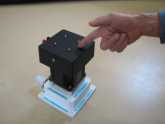FilterGuy
Solar Engineering Consultant - EG4 and Consumers
I have an off-grid mountain cabin being powered by a micro-hydros system.

The is what the turbine/alternator looks like.

Edit: added pic of the turbine.
- The turbine is called a Watter Buddy. https://microhydropower.com/our-products/watter-buddy/ I get a continuous 120 Watt at nominal 24V out of this little turbine (2880 Whr/Day). (I estimate I am using 1300 W-hr/day so that is enough to power the cabin.
- I am currently using 4 6V 230AH flooded lead acid batteries in a 24volt configuration. This is probably more storage than is really needed but I was afraid of running out. (I am looking at changing this to LiFePO4)
- I am using a CotekSD2500-124 2500 W inverter. https://www.cotek.com.tw/product/Pa...ave-Inverter-with-AC-By-pass-Function-SD2500/
- I am using a Xantrex C35 charge controller in Diversion Control Mode. (It sheds unused power to a power resistor in order to prevent over voltage and free-spin on the turbine.
- When the Cabin is not in use, the turbine is shut down and put away. Consequently I added a 20 watt (36Volt Open Circuit) solar pannel to keep the battery charged when not in use.

The is what the turbine/alternator looks like.

Edit: added pic of the turbine.
Last edited:



